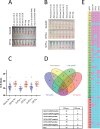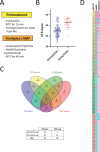Rapid SARS-CoV-2 testing in primary material based on a novel multiplex RT-LAMP assay
- PMID: 33137122
- PMCID: PMC7605681
- DOI: 10.1371/journal.pone.0238612
Rapid SARS-CoV-2 testing in primary material based on a novel multiplex RT-LAMP assay
Abstract
Background: Rapid and extensive testing of large parts of the population and specific subgroups is crucial for proper management of severe acute respiratory syndrome coronavirus 2 (SARS-CoV-2) infections and decision-making in times of a pandemic outbreak. However, point-of-care (POC) testing in places such as emergency units, outpatient clinics, airport security points or the entrance of any public building is a major challenge. The need for thermal cycling and nucleic acid isolation hampers the use of standard PCR-based methods for this purpose.
Methods: To avoid these obstacles, we tested PCR-independent methods for the detection of SARS-CoV-2 RNA from primary material (nasopharyngeal swabs) including reverse transcription loop-mediated isothermal amplification (RT-LAMP) and specific high-sensitivity enzymatic reporter unlocking (SHERLOCK).
Results: Whilst specificity of standard RT-LAMP assays appears to be satisfactory, sensitivity does not reach the current gold-standard quantitative real-time polymerase chain reaction (qPCR) assays yet. We describe a novel multiplexed RT-LAMP approach and validate its sensitivity on primary samples. This approach allows for fast and reliable identification of infected individuals. Primer optimization and multiplexing helps to increase sensitivity significantly. In addition, we directly compare and combine our novel RT-LAMP assays with SHERLOCK.
Conclusion: In summary, this approach reveals one-step multiplexed RT-LAMP assays as a prime-option for the development of easy and cheap POC test kits.
Conflict of interest statement
F.Z., O.O.A., J.S.G., J.J., and A.L. are inventors on patent applications related to SHERLOCK technology filed by the Broad Institute, with the specific aim of ensuring this technology can be made freely, widely, and rapidly available for research and deployment (US provisional application no. 62/975,743, "CRISPR Effector System Based Coronavirus Diagnostics"). This does not alter our adherence to PLOS ONE`s policies on sharing data and materials. O.O.A., J.S.G., and F.Z. are co-founders, scientific advisors, and hold equity interests in Sherlock Biosciences, Inc., and Pine Trees Health, Inc. F.Z. is also a co-founder of Editas Medicine, Beam Therapeutics, Pairwise Plants, and Arbor Biotechnologies. NAT is employed by New England Biolabs, Inc, manufacturer of the LAMP reagents and some additional enzymes described in this manuscript. All of the aforementioned does not alter our adherence to PLOS ONE`s policies on sharing data and materials. The remaining authors declare no competing financial interests.
Figures


Similar articles
-
A colorimetric RT-LAMP assay and LAMP-sequencing for detecting SARS-CoV-2 RNA in clinical samples.Sci Transl Med. 2020 Aug 12;12(556):eabc7075. doi: 10.1126/scitranslmed.abc7075. Epub 2020 Jul 27. Sci Transl Med. 2020. PMID: 32719001 Free PMC article.
-
Development and Clinical Application of a Rapid and Sensitive Loop-Mediated Isothermal Amplification Test for SARS-CoV-2 Infection.mSphere. 2020 Aug 26;5(4):e00808-20. doi: 10.1128/mSphere.00808-20. mSphere. 2020. PMID: 32848011 Free PMC article.
-
Validation of a single-step, single-tube reverse transcription loop-mediated isothermal amplification assay for rapid detection of SARS-CoV-2 RNA.J Med Microbiol. 2020 Sep;69(9):1169-1178. doi: 10.1099/jmm.0.001238. Epub 2020 Jul 31. J Med Microbiol. 2020. PMID: 32755529 Free PMC article.
-
Recent progress on the diagnosis of 2019 Novel Coronavirus.Transbound Emerg Dis. 2020 Jul;67(4):1485-1491. doi: 10.1111/tbed.13620. Epub 2020 May 31. Transbound Emerg Dis. 2020. PMID: 32395897 Free PMC article. Review.
-
Overcoming the bottleneck to widespread testing: a rapid review of nucleic acid testing approaches for COVID-19 detection.RNA. 2020 Jul;26(7):771-783. doi: 10.1261/rna.076232.120. Epub 2020 May 1. RNA. 2020. PMID: 32358057 Free PMC article. Review.
Cited by
-
Performance of the RT-LAMP-based eazyplex® SARS-CoV-2 as a novel rapid diagnostic test.J Clin Virol. 2021 May;138:104817. doi: 10.1016/j.jcv.2021.104817. Epub 2021 Apr 1. J Clin Virol. 2021. PMID: 33836452 Free PMC article.
-
Evaluation of RT-qPCR and Loop-Mediated Isothermal Amplification (LAMP) Assays for the Detection of SARS-CoV-2 in Argentina.Genes (Basel). 2021 Apr 28;12(5):659. doi: 10.3390/genes12050659. Genes (Basel). 2021. PMID: 33924826 Free PMC article.
-
Isothermal amplification and fluorescent detection of SARS-CoV-2 and SARS-CoV-2 variant virus in nasopharyngeal swabs.PLoS One. 2021 Sep 17;16(9):e0257563. doi: 10.1371/journal.pone.0257563. eCollection 2021. PLoS One. 2021. PMID: 34534259 Free PMC article.
-
Colorimetric RT-LAMP SARS-CoV-2 diagnostic sensitivity relies on color interpretation and viral load.Sci Rep. 2021 Apr 27;11(1):9026. doi: 10.1038/s41598-021-88506-y. Sci Rep. 2021. PMID: 33907239 Free PMC article.
-
Vivid COVID-19 LAMP is an ultrasensitive, quadruplexed test using LNA-modified primers and a zinc ion and 5-Br-PAPS colorimetric detection system.Commun Biol. 2023 Mar 2;6(1):233. doi: 10.1038/s42003-023-04612-9. Commun Biol. 2023. PMID: 36864129 Free PMC article.
References
-
- Anahtar MN, McGrath GEG, Rabe BA, Tanner NA, White BA, Lennerz JKM, et al. Clinical assessment and validation of a rapid and sensitive SARS-CoV-2 test using reverse-transcription loop-mediated isothermal amplification. medRxiv. 2020:2020.05.12.20095638. 10.1101/2020.05.12.20095638 - DOI - PMC - PubMed
-
- Baek YH, Um J, Antigua KJC, Park JH, Kim Y, Oh S, et al. Development of a reverse transcription-loop-mediated isothermal amplification as a rapid early-detection method for novel SARS-CoV-2. Emerg Microbes Infect. 2020;9(1):998–1007. Epub 2020/04/21. 10.1080/22221751.2020.1756698 . - DOI - PMC - PubMed
-
- Lu R, Wu X, Wan Z, Li Y, Jin X, Zhang C. A Novel Reverse Transcription Loop-Mediated Isothermal Amplification Method for Rapid Detection of SARS-CoV-2. Int J Mol Sci. 2020; 21(8). Epub 2020/04/25. doi: 10.3390/ijms21082826 - DOI - PMC - PubMed
MeSH terms
Substances
LinkOut - more resources
Full Text Sources
Other Literature Sources
Miscellaneous

